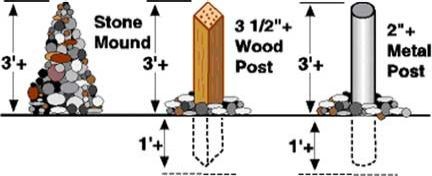Staking a Claim
Federal law specifies that claim boundaries must be distinctly and clearly marked to be readily identifiable. Most states have statutes and regulations concerning the actual staking and recording of mining claims so claimants should refer to the appropriate state agency for additional requirements before locating a claim.
Prior to locating a claim, a prospector should check BLM records for prior recorded claims. Ultimately, the prospector must check for prior existing claim markings on the ground.
Departmental decisions require a discovery on each claim, based on actual physical exposure of the valuable mineral within the claim boundaries. (Also, each 10 acres on a placer claim, after a discovery, must be mineral in character.)
Most State laws require conspicuous and substantial monuments for all types of claims and sites.

Note: These are generalized examples of conspicuous and substantial monuments. However, consult state law to determine acceptable requirements for your state. It is BLM’s policy to not use perforated or uncapped pipe as a monument.
Who can stake a claim?
United States citizens who have reached the age of discretion under the law of the state of residence; or legal immigrants who have declared their intention to become a citizen; or a corporation organized under the laws of any state may locate a mining claim. The government considers a corporation the same as a U.S. citizen.
An agent may locate a mining claim on behalf of a claimant.
A claimant may hold any number of claims or sites.
